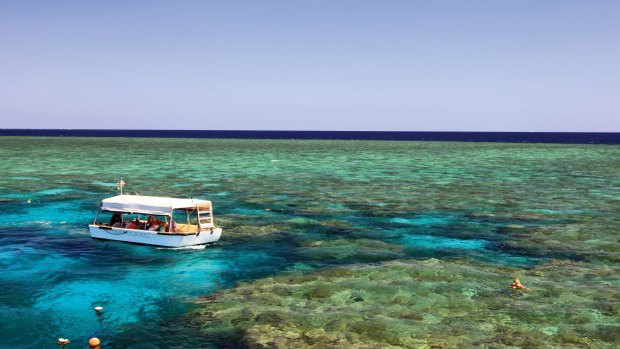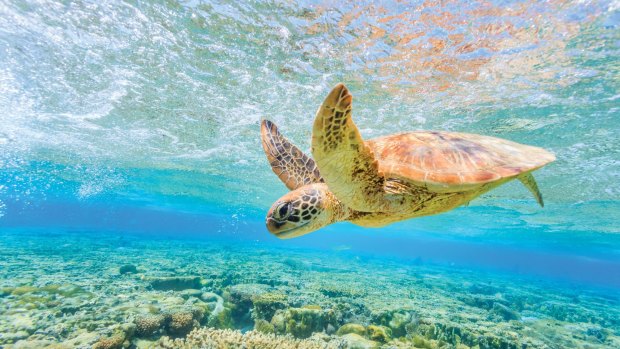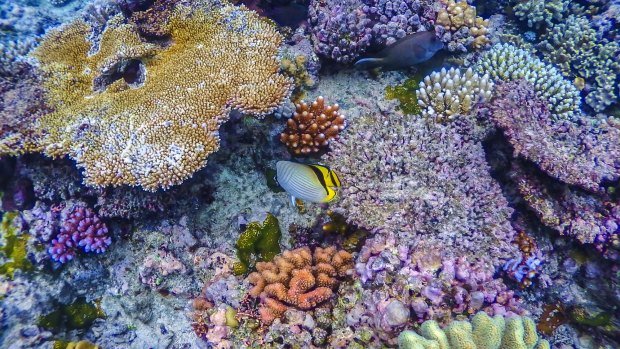This was published 5 years ago
Cruise Australia: The northern parts of the Great Barrier Reef are heaven for divers and snorkellers
By Caroline Gladstone

A Coral Expeditions glass bottom boat at Nathan Reef.Credit: Coral Expeditions
It's 4.30pm when our landing craft pulls into Watson's Bay on Lizard Island, a continental granite island 27 kilometres offshore and 93 kilometres north of Cooktown. Balmy and slightly overcast, the conditions aren't ideal, but a group of novice divers are keen to test their scuba gear and the rest of us want to snorkel out to the famous Clam Gardens.
Within minutes of easing into the warm waters, I spot a small turtle drifting by. Fifty metres out I spy my first giant clam, sitting on the sea bed not far below, looking like a big clutch purse with fuzzy iridescent blue lips. Then there's another and another of these tridacna gigas, which can grow to two metres.
As I float over them, each quickly closes, and it seems as if they are winking at me. That's perfectly understandable, of course, as I am wearing a rather fetching black stinger suit.

A green sea turtle on the Great Barrier Reef.Credit: Coral Expeditions
It's April and stinger season in Queensland; the six-month period when deadly box-jelly fish and the tiny, less lethal, Irukandji inhabit the warm waters. All 27 passengers aboard the catamaran Coral Expeditions II buy a suit, which at $30 is a bargain for protection against painful stings or something infinitely worse.
Made of fine mesh and complete with separate hood, gloves and footlets, the suit is really a big black pantyhose. Had I known I'd be wearing one of these, I'd have dieted for a month.
Emerging from the deep after the flirtatious clam encounter, I see the crew has set up chairs and a spread of canapes and drinks awaits. The light is fading and it's the perfect opportunity to sit back, relax and get to know fellow passengers after a busy day that began with an early arrival into Cooktown and a visit to the fascinating James Cook Museum.

Coral at Escape Reef - our last snorkelling and diving spot.Credit: Coral Expeditions
Housed in the former 1888-built St Mary's Convent, the museum's prize exhibits are a cannon from Captain Cook's Endeavour, one of six he jettisoned overboard to lighten the load when the Endeavour struck the Great Barrier Reef in June 1770, and the ship's anchor. It's remarkable that these rusty pieces were only fished out of the deep in the early 1970s.
This is our first full day on the northern Great Barrier Reef cruise, which departs Cairns every Monday afternoon and combines visits to Cooktown and Lizard with days of blissful snorkelling and diving on spectacular reefs located beyond the reach of day-trippers.
It's blissful if the weather is kind. It wasn't during the previous three-night cruise, which copped the tail end of cyclone Iris, according to our Irish captain, Gary, and four passengers who stayed on-board for another trip.
Luck plays a big part in any trip to the Tropics and it is our good fortune to have smooth sailing and mostly clear skies.
We overnight off Lizard Island in readiness for early shore activities the next day. I take the 8am tender to the Lizard Island Research Station and meet joint-directors and married couple Lyle Vail and Anne Hogget. They have been on the island since they arrived with their four-year-old son in 1990.
Opened in 1973, the station, which is run by the Australian Museum, had a humble beginning with just six tents on the beach. Today there is accommodation for 39 researchers and students (who study projects from coral bleaching to the effect of climate change on fish behaviours), laboratories and aquarium tanks.
We peer into several containing the notorious crown of thorns starfish, or COTS to the scientists, an ugly creature if ever there was. Lyle's description of how they go into "outbreak mode" and spread like a locust plague producing 500 new starfish in 15 minutes is a horror story. The first major outbreak happened in the 1960s and there have been four documented outbreaks since, the last in 2009-10.
While the creatures are native to the reef and have a role in controlling fast-growing plate coral, they are voracious during an outbreak when thousands feast on hard coral, starting with the staghorns.
"We can kind of control it in patch areas," Lyle says, "but it is frustratingly show." The cure, which involves injecting ox bile into individual creatures by human divers and recently-programmed robots, sounds to me like another sci-fi horror tale, albeit a fascinating one.
It's good to learn Coral Expeditions is involved in this "envenoming" task and in reporting mass sightings to the COTS Control Program.
From Lizard Island we cruise south to Ribbon Reef No. 9 and squeeze into our stinger suits for our first chance to snorkel and dive from the ship's rear hydraulic platform. Ribbon reefs, which number one to 10 from south to north are located 50 to 100 kilometres offshore on the outer Great Barrier Reef, along the edge of the continental shelf. They offer the best diving and we don't see another vessel anywhere when anchored just metres from No. 9 nor at No 3 the next day.
Sixteen passengers are taking their first ocean plunge after having a free beach lesson at Lizard. I stick to snorkelling and take a couple of glass-bottom boat rides. This is some of the best snorkelling I've ever experienced – hundreds of colourful fish, great drop-offs, plenty of bright coral and not a nasty starfish to be seen.
Our last site, Escape Reef, south of the ribbons, is my favourite. It has a lagoon and ocean "side", and I explore both, always under the watchful eye of two lookouts who stand on the ship's upper decks ensuring no-one gets into difficulty. Crew can act as snorkel buddies if passengers need them and flotation devices are provided.
Stretching for 2300 kilometres and comprised of 3000 individual reefs and 600 continental islands, the Great Barrier Reef is huge – the size of Italy the crew tells us. We get just a glimpse of it, but it's a brilliant glimpse thanks to near-ideal conditions and Coral Expeditions' know-how gleaned from 35 years in the business.
TRIP NOTES
FLY
Qantas, Virgin and Jetstar operate regular flights to Cairns from Sydney and Melbourne. See qantas.com; virginaustralia.com; jetstar.com
CRUISE
Coral Expeditions II is a twin-hulled catamaran with capacity for 44 passengers in four styles of accommodation ranging from twin-bedded cabins to upper deck staterooms and large deluxe staterooms with double beds. Activities include reef talks and videos, snorkelling, diving, kayaks and glass-bottom boat rides. Thirty-minute tank drives cost from $98 a person.
Three-, four- and seven-night cruises depart Cairns. Three-night southern cruises visit Hinchinbrook Channel and Fitzroy Island. The seven-night cruise is a combination of both; three-night cruise from $1800 a person, twin share. Solo travellers pay no single supplement.
Caroline Gladstone travelled as a guest of Coral Expeditions.
Sign up for the Traveller Deals newsletter
Get exclusive travel deals delivered straight to your inbox. Sign up now.